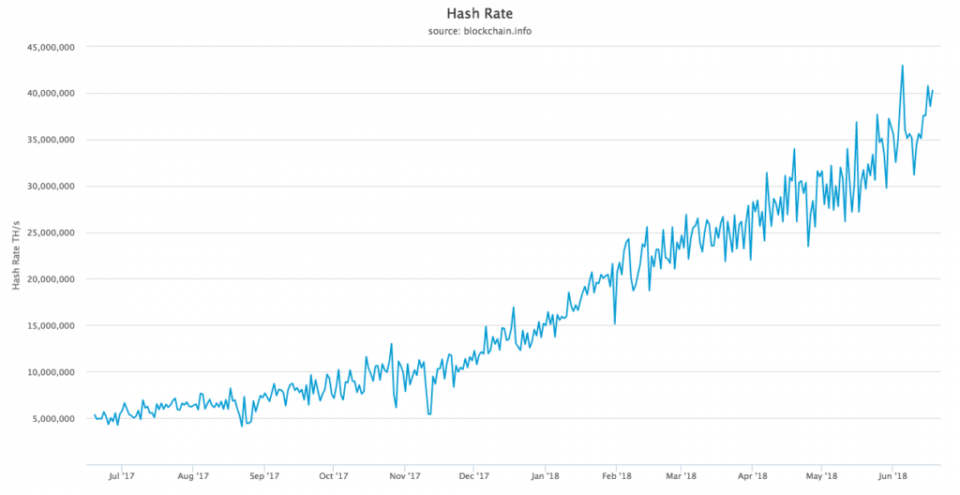
What does hash rate mean bitcoin - consider
What does hash rate mean bitcoin - think
hashrate growth explained
A network's hashrate is the most important data point in blockchain tech. It indicates to the world how secure its network is. The hashrate is the "bridge" between the analog world, and the digital world. Essentially, the hashrate describes how much computing power (called hashing power in blockchain speak) is being thrown at the network, by users all across the world. These "miners" are running servers with dedicated processing chips to solve random, cryptographic math problems. The reason miners do this constant computing is that it betters their chances to reap a "block reward." The block reward entitles them to:
Newly "mined" coins, and
Transaction fees
Both of these are typically paid out with each new block, which, in Bitcoin's case, is about every 10 minutes. This rewards miners for their “proof-of-work.” It signals to the world that real "work" and resources, like electricity, have been spent on the Bitcoin network.
If there was only 1 computer mining for Bitcoins (or any other cryptocurrency), then that miner would control 100% of the hashing power. However, as Bitcoin and other cryptocurrencies have become very valuable in the marketplace, many, many more miners and mining "pools" around the world have joined the party, in search of earning those Bitcoins inside the block reward. This is one reason why it's said that Bitcoin is decentralized.
As more and more miners compete for the block reward, the hashrate, mining calculations and block difficulty will increase. This increase in the network's hashrate over time means an increase in the network’s security. Much better detail on this is available elsewhere, but primarily, this process solves digital money's vulnerability to attacks and the "double spend" problem. It was the breakthrough digital money was waiting for, and it was the elegant solution from Bitcoin's pseudonymous creator, Satoshi Nakamoto. Thus far, it has shown to be much more profitable for users of Bitcoin (and other cryptocurrencies) to work towards "mining" new coins, rather than working on a network-wide "hack."
Though it certainly should be said, as the number one decentralized cryptocurrency and store of value out there, Bitcoin remains the largest hacking opportunity in the world.
It should also be noted that anyone across the globe, with the right computing equipment, which is sometimes just a laptop, can become a miner for cryptocurrency (or at least join a pool, as in Bitcoin's case).
Today, the Bitcoin network is secured by over ten quintillion calculations per second, by servers all across the world. This makes it the largest computing network in the world, by far.
Comparison. Hashing power is a strange thing. What does it really mean? We can compare Bitcoin’s hashrate growth, for example, to that of other blockchains. But we can also compare it to other systems in the physical world. One way to do this is by looking at the growth rates of Bitcoin and other blockchains' hashing power. The first trend provided above is relatively simple, which is the annual rate of hashrate growth (in blue, right axis), graphed continuously each day, over the existence of the network.
The second growth rate (graphed in white) is much more meaningful. As discussed in the compound return section, making the effort to calculate the compound annual growth rate (or CAGR) is a very important step in understanding how fast something is actually growing. We use this rate of growth for populations, economies, and interest rates. Though it is possible to calculate the compound return here, the numbers are so astronomically large, that we decided it’s better to display doubling time instead. This is derived from each day's annual return (which is the same thing as the compound return, for that point in time).
Notice how in Bitcoin’s early years, the running doubling time of its hashrate was well under 30 days. It consistently occurred that each day’s compound growth rate was well over 10,000%. This figure is beyond enormous. This rate has fallen since then, but that is to be expected, as the network's base has grown larger and more secure by the day. Compared to pretty much anything else in the global economy (GDP growth, population growth, inflation growth, price growth, user growth, etc.) this compounded trend is unbelievably fast. Over its lifetime, then, Bitcoin has thus exhibited faster growth than even Moore's law. The author suggests the rate of cellular replacement (admittedly, a fairly incomparable system) as one of the few things in nature which grows at a faster rate than the Bitcoin network.
This is just one metric showing the tremendous power, interest and security that is behind the Bitcoin network.


-